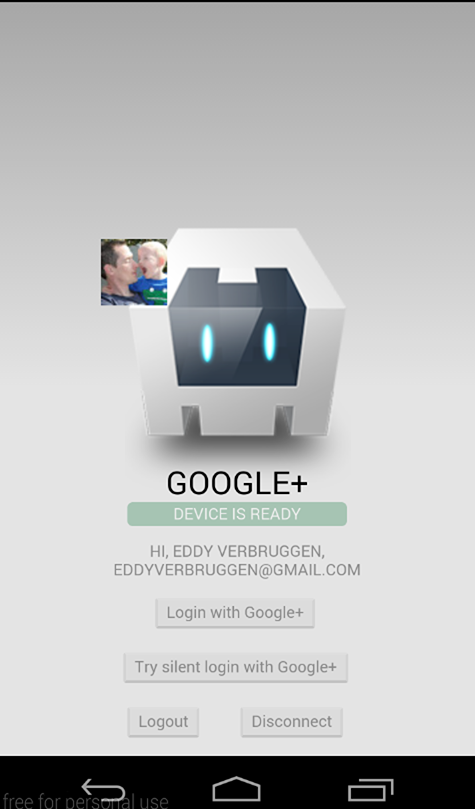- Description
- Screenshots
- Installation (CLI / Plugman)
- Google+ API setup
- Usage
- Troubleshooting
- Changelog
- License
Installing this plugin directly from Cordova Registry results in Xcode using a broken GoogleOpenSource.framework and GooglePlus.framework, this is because the current publish procedure to NPM breaks symlinks CB-6092. Please install the plugin through a locally cloned copy or re-add the frameworks to Xcode after installation.
This plugin allows you to log on with your Google account on iOS and Android. You will not only get the email address of the user, but also stuff like their full name and gender.
Android
iOS
This plugin is compatible with Cordova Plugman, compatible with PhoneGap 3.0 CLI, here's how it works with the CLI (backup your project first!):
Using the Cordova CLI and the Cordova Plugin Registry
$ cordova plugin add nl.x-services.plugins.googleplus
$ cordova prepare
Or using the phonegap CLI
$ phonegap local plugin add nl.x-services.plugins.googleplus
GooglePlus.js is brought in automatically. There is no need to change or add anything in your html.
To communicate with Google+ you need to do some tedious setup, sorry.
To get your iOS API key, follow Step 1 of this guide
To configure Android, follow Step 1 of this guide
Make sure you execute the keytool steps as well or authentication will fail.
Check the demo app to get you going quickly, or hurt yourself and follow these steps.
Note that none of these methods should be called before deviceready has fired.
window.plugins.googleplus.login(
{
'iOSApiKey': '1234567890-abcdefghijklm74bfw.apps.googleusercontent.com'
// there is no API key for Android; you app is wired to the Google+ API by listing your package name in the google dev console and signing your apk (which you have done in chapter 4)
},
function (obj) {
alert(JSON.stringify(obj)); // do something useful instead of alerting
},
function (msg) {
alert('error: ' + msg);
}
);Note that if you're only targeting Android you can pass {} for the first argument.
The success callback (second argument) gets a JSON object with the following contents, with example data of my Google+ account:
obj.email // 'eddyverbruggen@gmail.com'
obj.userId // user id
obj.displayName // 'Eddy Verbruggen'
obj.gender // 'male' (other options are 'female' and 'unknown'
obj.imageUrl // 'http://link-to-my-profilepic.google.com'
obj.givenName // 'Eddy'
obj.middleName // null (or undefined, depending on the platform)
obj.familyName // 'Verbruggen'
obj.birthday // '1977-04-22'
obj.ageRangeMin // 21 (or null or undefined or a different number)
obj.ageRangeMax // null (or undefined or a number)
obj.idToken
obj.oauthTokenWhen the user comes back to your app and you're not sure if he needs to log in,
you can call trySilentLogin to try logging him in.
If it succeeds you will get the same object as the login function gets,
but if it fails it will not show the authentication dialog to the user.
The code is exactly the same a login, except for the function name.
window.plugins.googleplus.trySilentLogin(
{
'iOSApiKey': '1234567890-abcdefghijklm74bfw.apps.googleusercontent.com'
},
function (obj) {
alert(JSON.stringify(obj)); // do something useful instead of alerting
},
function (msg) {
alert('error: ' + msg);
}
);This will clear the OAuth2 token.
window.plugins.googleplus.logout(
function (msg) {
alert(msg); // do something useful instead of alerting
}
);This will clear the OAuth2 token and forget which account was used to login. On Android this will always force the user to authenticate the app again, on iOS using logout seems to do the job already. Need to investigate this a bit more..
window.plugins.googleplus.disconnect(
function (msg) {
alert(msg); // do something useful instead of alerting
}
);-
Q: After authentication I'm not redirected back to my app.
-
A: You probably changed the bundle id of your app after installing this plugin. Make sure that (on iOS) the
CFBundleURLTypesbit in your.plistfile is the same as the actual bundle id originating fromconfig.xml. -
Q: I can't get authentication to work on Android. And why is there no ANDROID API KEY?
-
A: On Android you need to execute the
keytoolsteps, see the installation instructions for details.
1.0.0: initial version supporting iOS and Android
Permission is hereby granted, free of charge, to any person obtaining a copy of this software and associated documentation files (the "Software"), to deal in the Software without restriction, including without limitation the rights to use, copy, modify, merge, publish, distribute, sublicense, and/or sell copies of the Software, and to permit persons to whom the Software is furnished to do so, subject to the following conditions:
The above copyright notice and this permission notice shall be included in all copies or substantial portions of the Software.
THE SOFTWARE IS PROVIDED "AS IS", WITHOUT WARRANTY OF ANY KIND, EXPRESS OR IMPLIED, INCLUDING BUT NOT LIMITED TO THE WARRANTIES OF MERCHANTABILITY, FITNESS FOR A PARTICULAR PURPOSE AND NONINFRINGEMENT. IN NO EVENT SHALL THE AUTHORS OR COPYRIGHT HOLDERS BE LIABLE FOR ANY CLAIM, DAMAGES OR OTHER LIABILITY, WHETHER IN AN ACTION OF CONTRACT, TORT OR OTHERWISE, ARISING FROM, OUT OF OR IN CONNECTION WITH THE SOFTWARE OR THE USE OR OTHER DEALINGS IN THE SOFTWARE.





